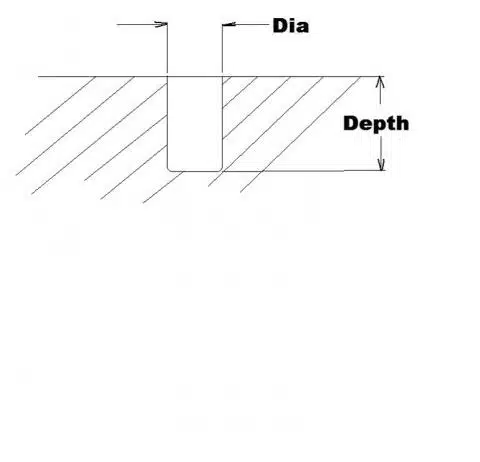
Blind holes and pockets are common features of investment casting designs. They serve to lighten the part, provide designed clearances and are examples of the type of detail that can often be provided by the investment casting process at negligible cost to a customer.
For any feature to be castable, it is necessary for an IC foundry to build a minimum number layers of ceramic shell in or about it. The ratio between the diameter of a hole and its depth determines if the ceramic shell will fully form. By definition blind holes & pockets are open from only one end and are more difficult to build layers of ceramic than are through-holes that are open from two ends. As blind holes are more difficult it follows that the castable ratio between the diameter and depth is different than it is for through holes (see the OFC Blog on Through Holes for more information).
The greater the diameter of the blind hole the greater the depth that it can be cast. For example a Ø.12” diameter blind hole can be cast .12” in depth (1x) whereas a Ø.50” diameter blind hole can be cast .75” in depth (x1½). O’Fallon Casting publishes an Investment Casting Design Guide that is available for free download on its website. The Design Guide contains a table that delineates the castable sizes of blind holes.
All blind holes & pockets must have a fillet radius around the base of the feature. A fillet is critical as a sharp corner can potentially cause a failure in the casting process to produce the feature (see the OFC Blog on Fillet radii for more information). A minimum fillet radius of .06”R is recommended or a full spherical radius with Ø.12” or smaller diameter blind holes.
Investment casting wax patterns are produced with injection molds and blind holes and pockets are “positive” features in a mold. As the injected pattern wax cools and contracts the pattern will tend to adhere to those positives. A small amount of draft angle on pocket walls can sometimes help to facilitate the removal of the wax pattern from the mold. Although a draft angle is not generally required for investment casting designs an allowance to tool blind pockets with up to a 1° of draft may benefit the manufacturability of the part.
Working within the recommendations in the Design Guide will help to prevent cast features from becoming a cost drivers. Should it be necessary to design a feature outside those recommendations we suggest that you consult a foundry to determine if there is any impact on part manufacturability and of any cost implications. It is very likely that a foundry can suggest changes that will improve a part’s castability without impacting its cost.
If you have any questions regarding the casting of Blind Holes & Pockets, contact your O’Fallon Casting Sales Engineer.
